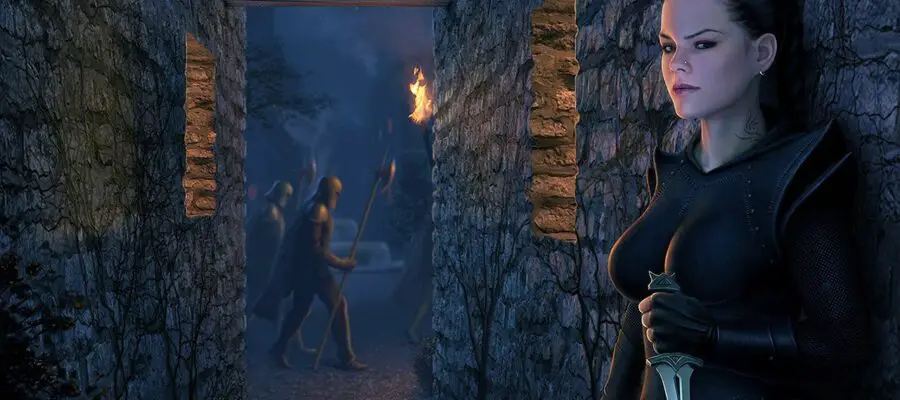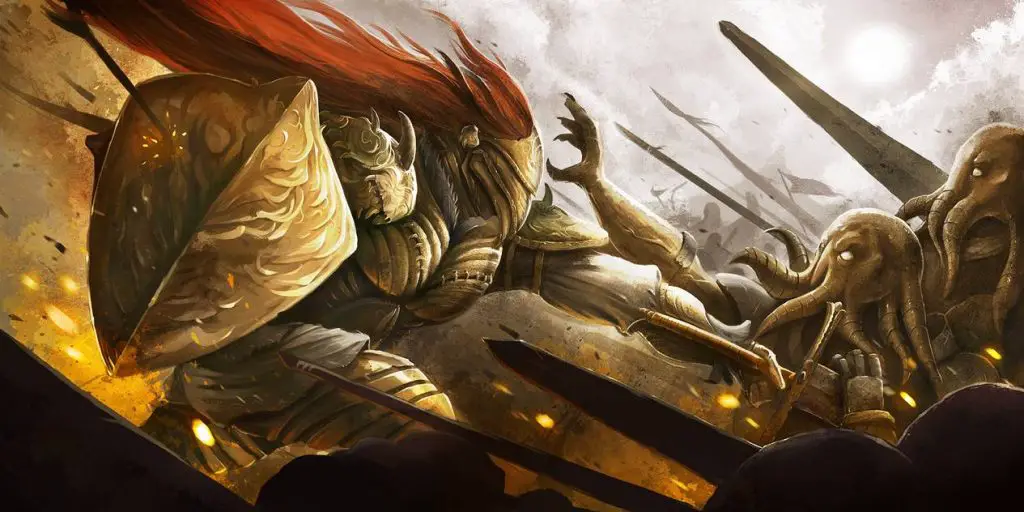Assassin Rogue Grave Cleric multiclass featured art is “Assassin” by Deligaris, CC Attribution-Noncommercial-No Derivative Works 3.0 License
I have discovered a multiclass combination most frightening to behold… the Assassin of the Grave. This combination is based on dealing over 500 damage in one satisfying strike, and I’m not even including spells or magic items. This is just pure damage from class abilities and a rapier.
Imagine This:
A corrupt noble is pacing his lavish quarters as the full moon shines through his grand window. He has recently doubled his mercenary employ due to suspicions that his live is threatened. Sweating and whispering to himself, he wonders if his security force is enough. Unbeknownst to him, an assassin’s arm raises up from behind a curtain, finger pointing to curse him with a swift trip to the underworld. A shadow dashed across the wall as the assassin springs from her hiding place, blade brandished. The nobleman’s flesh and bones give little protection to his pounding heart. The blade stabs as if through hot butter. His heart stops in an instant. His body pales quickly as his soul is removed by a beckoning god. Before the body hits the floor, the assassin has disappeared. The falling corpse lands on the artisan rug with an ephemeral thud, followed by eerie silence as the full moon’s light disappears behind a dark clouds. Who in the slave trade will take the place of this corrupt nobleman? If the assassin has any say in it, nobody.
Mechanics
This multiclass option specializes in quickly dispatching a single target with deity-decreed deadliness. Here are the necessary character mechanics:
18 Levels – Rogue: Assassin archetype
- Sneak Attack (9d6)
- Assassinate (level 3)
- Death Strike (level 17)
2 Levels – Cleric: Grave archetype
- Channel Divinity: Path to the Grave (Cleric of the Grave)
The Assassin of the Grave utilizes this multiclass combo by sneaking up on a target to use the Channel Divinity: Path to the Grave action, remaining hidden, followed by a roguish attack on the following turn. What does the assassin gain with this? According to the Assassinate feature, a rogue will automatically turn a successful weapon attack into a critical hit if the target is surprised.
This assassin will mark a target with Path to the Grave, making it vulnerable to the next instance of damage it receives (x2 damage). The Death Strike assassin feature doubles your attack’s damage, meaning your amplified attack can effectively deal a maximum of x4 DAMAGE!
( (2d8 rapier) + (18d6 sneak attack) + dex mod 5) * 4 = Min 100, Max 516, Average 308
Minimum = (2+18+5) * 2 * 2 = 100
Maximum = (16+108+5) * 2 * 2 = 516
Average = (9+63+5) * 2 * 2 = 308
This is the kind of out-of-context damage you brag to your crush about, no doubt.
Variations
Instead of multiclassing, you and your buddy could create a cleric and rogue deadly duo. The cleric marks the target and the rogue strikes. This combination is guaranteed to bring players together in a bond of everlasting D&D friendship. The cleric just needs to learn to be sneaky along with the rogue companion.
Narratively, perhaps they are a pair of crusaders dealing death to the deserving wicked. Alternatively, maybe rumors spread about a bounty hunter who is particularly deadly, but the rumors fail to realize that the legendary bounty hunter is actually a pair of killers. There are so many ways to roleplay this combination!
Rules Lawyer
Does Path of the Grave stack with Death Strike?
Yes! One is based on a multiplier, while the other is based on vulnerability. A similar question arises commonly for magic effects; in these cases, the PHB says the same magical effect cannot stack with itself (such as two Cloudkills only dealing damage as if there is one cloud). Similarly, questions arise about having multiple effects that multiply proficiency bonus, such as expertise and other effects; in these cases, you cannot multiply the proficiency bonus twice. For these reasons, it is clear that Path of the Grave can stack with Death Strike.
The target becomes vulnerable to the next instance of damage it takes. Death Strike doubles an attack’s damage. You cannot double up the same effect in 5E, but since these two effects are technically different, they can both occur simultaneously.
Can you use Channel Divinity: Path of the Grave while remaining concealed until your surprise attack?
Yes! Neither the general Channel Divinity description nor Path of the Grave description say you need to do anything as part of the action that would reveal you to your prey.
Having said that, I know some DMs won’t interpret the rules this way. That’s fine; it’s a gray area. Let me explain why a player or DM may see it my way. The ruling is based on an interpretation of what a perceptible hostile action is. This Channel Divinity doesn’t directly harm the enemy or broadcast that a hostile action has been taken. It only says you point at them. They don’t feel anything until they take damage.
Picture this: you used the Channel Divinity and the DM said “ROLL INITIATIVE!” This means your first turn in combat is spent doing the Channe Divinity, meaning you ruin the surprise round and this combination fails. But what if you didn’t do anything on your next turn and you didn’t reveal yourself from being hidden?…. Does combat just stop or did it never start in the first place? If you were hidden, you probably remained hidden when you pointed at someone. This is why I rule the way I do on this. If you’re doing something that wouldn’t cause enemies to be hostile toward you in open combat regardless of what you do next, combat should not have begun.
The same principle applies if a vampire uses a natural ability to charm someone or an illusion enters a room. If someone else notices a person become charmed, they might make a fuss. Someone noticing an illusion for what it is may cry out in alarm and cause a commotion. It’s not always obvious when Initiative should be rolled and combat should begin.
I have an article about how ‘surprise’ works if you want to read that, too. I tried to make it as helpful as possible since surprise rules are commonly misunderstood (and they aren’t always clear in how they should be applied in a game).
How do the rules work for surprising an enemy?
You will want to brush up on how surprise rounds work, so read my article on how surprise works in 5e. Make sure you and your DM are in agreement. Initiative will be important. If your initiative is lower than your target’s, you don’t apply the Assassin auto-crit. The target did not benefit from taking an action/reaction or moving in the surprise round. However, they still technically took a turn, nullifying the Assassin feature for auto-crit.
This is explained by considering PHB p.189, where it reads, “If you’re surprised, you can’t move or take an action on your first turn of the combat, and you can’t take a reaction until that turn ends. A group member can be surprised even if the other members aren’t” (PHB p.189, italics added).
I bring this up because many groups probably play as if surprised creatures do not get a turn during the surprise round, but they do indeed get a turn to do nothing. Good luck on your initiative rolls!
Roleplay Opportunities
Here are several suggestions for how to roleplay this type of character:
- Servant to a god of death, carrying out the god’s will to reap the soon-departed.
- Professional killer who discovered the power behind an ancient holy symbol, allowing the wearer to rewrite destiny and hasten death’s hand.
- Vigilante, consecrated by a priest to bring swift justice to the wicked.
- Outcast, born with a horrible disease, earning shame and scorn from his village. Now he has overcome the disease, but discovered that he has inherited divine abilities to augment his skill with a blade.
- Outlander whose tribe was murdered by a large nation, and finds himself blessed by his ancestors to avenge them.
- Scientist whose adrenal levels spike before a stealthy kill.
There are examples from popular culture of characters who use special abilities to assassinate people. They each have unique belief systems that drive their goals and ambitions:
- Light Yagami (Death Note): Using power to compel people to obedience, considering himself a god.
- Hidan (Naruto: Shippuden): Glorifying his god and religion through killing.
- Death Gun (Sword Art Online II): Mysterious killer employing seemingly impossible methods of murder.
- Scar (Full Metal Alchemist): Avenging his people by destroying the soldiers who killed them.
- Udō Jin-e (Rurouni Kenshin): Bloodthirsty killer who uses war and politics to justify and fuel his murderous swordsmanship, killing friend and foe alike if it offers a thrill.
- Dovahkiin / Dragonborn (Elder Scrolls V: Skyrim): Marks foes for death with a Thu’um / Shout.
- Ghost Rider (Marvel Comics): Reaps a wicked person’s soul with his hellish powers.
Share Your Thoughts
In whatever way you choose to deploy this combination, you can bet the damage output will be staggering and satisfying. Have you already tried this combination? Is there anything I missed? What other ideas have you had that I should cover? Comment with your experiences and thoughts. See you in the next post!
Need help multiclassing? See our Ultimate How To Multiclass Guide.
Interested in other multiclassing combinations? See what works in this Multiclass Combinations Article. You can also find a necromancer concept that similarly uses Rogue + Cleric from Wally DM!
Check out our other multiclass builds:
- Druid Monk Beast Ninja: Monkey Fist
- Battle Master Rogue Multiclass
- Paladin Warlock Ranger Multiclass
- Arcane Assassin Archer Multiclass
- See our Ultimate 5e Rogue Fighter Multiclass Guide for our in-depth analysis on Rogue-Fighter combinations.





The House of White and Black from the Song of Ice and Fire books is a perfect example of this type of Assassins
Wow, I wasn’t familiar with this concept, but you’re totally right! It would be cool to create a similar organization in a D&D campaign.
“…remaining hidden, followed by a roguish attack on the following turn”
How can you hide & be in rapier melee range, standing next to the enemy, & not expect them to move? That seems like a very rare opportunity. If you move you lose stealth. I am having trouble understanding this situation.
Hi Paul, a character actually can move while being stealthy and hidden. The PHB has a description on page 177 with examples of moving stealthily: “Stealth. Make a Dexterity (Stealth) check when you attempt to conceal yourself from enemies, slink past guards, slip away without being noticed, or sneak up on someone without being seen or heard.” Does this clarification help you understand how you can mark someone with Channel Divinity and then proceed to move and attack them while hidden?
As for how rare the opportunity is, I’ve played an assassin and found many circumstances like the one I described. I think the opportunity is common if you seek it out as an assassin would. An assassin could be in disguise hiding in plain sight, or hiding behind a curtain as the target approaches the window. Assassins could be jumping from a rooftop for an aerial attack, or using a crowd to conceal the attack. 🙂
“When you target an enemy with your Channel Divinity then Initiative is rolled, as it would be for any creature taking hostile action against any other. Initiative resolves before the triggering action, so you are currently in initiative order. If you beat your target in initiative then you can mark it with Path To The Grave, but then it’s the target’s turn. They may not even know you’re there, they may not act, but at the end of their turn they lose the Surprised condition because technically they have gone through a turn in combat. When it gets to your turn they are not currently Surprised and so your Assassinate feature cannot trigger an automatic critical hit.” Scroll down at this link: https://www.reddit.com/r/dndnext/comments/8aku10/grave_cleric_assassin/ IllithidActivity is right.
Hi Dungeon Mair,
You’re definitely correct if the DM interprets the Channel Divinity to be ‘hostile’ enough to trigger initiative/combat. Since the official start to combat is ambiguously based on hostility, I would reference Jeremy Crawford’s guidance on the subject: “As DM, you have many tools available to you in D&D to build a fun time. One of those tools is combat, and you decide when to utter the phrase that officially starts a fight: ‘Roll initiative!’ The rules tell you when that roll normally happens, but in play, you decide.” (https://www.sageadvice.eu/2019/10/24/if-the-target-is-truly-unaware-of-the-attacker-how-can-he-then-get-an-initiative-roll-at-all-before-the-attacker-reveals-himself/)
I personally wouldn’t begin combat and roll initiative if an action is imperceptible enough since hostility is not obvious. For example, in a social encounter, if a Sorcerer used the Subtle Spell Metamagic to cast the Charm Person spell on a monarch, I wouldn’t require players to roll initiative for the remainder of the social encounter. The Grave Cleric’s Channel Divinity curse is invoked merely with pointing; it doesn’t force a saving throw or make an attack roll. It doesn’t even mention a change in the target’s emotional, mental, or physical state. If it did, I might rule that it is evidently hostile.
So while you and IllithidActivity are partially correct, the ruling is based on an ambiguous rule that many people I’ve played with would disagree with. I know it can seem like a cop out to say it’s up to the DM, but this rule really is inherently up to the DM.
Thanks for reading, and thank you for the healthy concept criticism! Comments like yours help us to keep our content accurate, widely useful, and updated. Happy adventuring. 🙂
Hi Flutes, thank you for your response. A convincing response it was! It reminds me of a similar RAW controversy that keeps troubling me: players who try to metagame by using the Ready action before combat/initiative. Crawford had a response to this as well: https://twitter.com/JeremyECrawford/status/778650357824040961?s=20 In this case, I’m not satisfied with Crawford’s response. After all, Hide, Help (e.g., to disarm a trap or whatever), and Cast a Spell are all listed under Actions in Combat, and yet they routinely occur outside of combat/initiative. So, why not Ready? As a DM, I’d adjudicate against pre-combat Ready in most cases. However, I might allow it if, for instance, a warlock used Ghostly Gaze to peer through a door into a room full of enemies and thereby knew their exact locations and the layout. It’s as you implied — and as Crawford has reminded us on many occasions: An important role of the DM is to make sure the game is fun. And that involves interpreting rule ambiguity, making exceptions to the rules, designing house rules and homebrews, etc. Apologies for being a rule stickler. I was actually invested in your giving me a good answer, because I’d built a big baddie on your Assassin of the Grave model. Now I feel justified in using this NPC and assassination tactic. My poor players!
You could add Fighter 2 for Action Surge.
First Action would be Channel Divinity, with Action Surge you follow up with Attack Action. Then there would be no discussion about surprise.
But you will lose sneak damage for losing 2 rogue levels.
Yes, two levels of Fighter would be helpful! As long as the DM doesn’t rule the Channel Divinity to reveal you, you can still surprise the foe with your Action Surge attack in the same turn.
if you use a Ring of Invisibility, a light crossbow/rapier +3 (proficiency gained by the Cleric/Rogue multiclass)
and lots of other things (including allied buffs, magic tems, spells and so on), you could deal even more damage!
For real, it gets pretty nuts when you start adding on more damage potential outside of the class features in the combo.